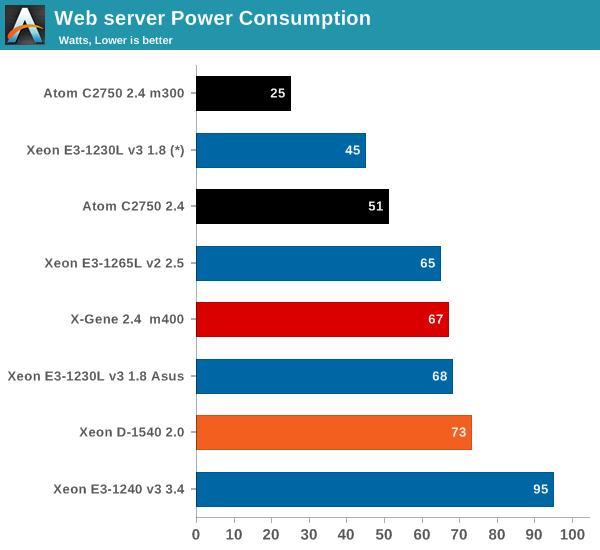The Intel Xeon D Review: Performance Per Watt Server SoC Champion?
by Johan De Gelas on June 23, 2015 8:35 AM EST- Posted in
- CPUs
- Intel
- Xeon-D
- Broadwell-DE
Web Infrastructure Power consumption
Next we tested the system under load.

(*) measured/calculated to mimic a Xeon-E3 "m300-ish" board.
Let us entangle the results by separating the power that goes to the SoC and the power that goes to the system. We did a similar though experiment in our X-Gene 1, Atom C2000 and Xeon E3 comparison.
| Power Consumption SoC Calculations | ||
| SoC | Power Delta = Power Web - Idle (W) |
Power SoC = Power Delta + Idle SoC + Chipset (W) |
| Xeon E3- 1240 v3 3.4 | 95-42 = 53 | 53+3+3 = 59 |
| Xeon E3-1230L v2 1.8 | 68-41 = 27 (45-18 = 27) |
27+3+3 = 33 |
| Xeon D-1540 | 73-31 = 42 | 42+2+0 = 44 |
| Atom C2750 2.4 | 25-11 = 13 | 13+3+0 = 16 |
Now let us combine our calculated SoC power consumption and the power measurements in the graph above. The Atom C2750 still make sense in a micro server if CPU performance is not a priority: think static webservers and caching servers. You can fit an Atom C2750 server inside a power envelop of 25W as HP has proven. Based upon our own experience, such a Xeon D system would probably require more like 55 - 60 W.
If CPU performance is somewhat important, the Xeon D is the absolute champion. A Xeon E3-1230L server with similar features (2x 10 Gb for example) will probably consume almost the same amount of power as we have witnessed on our Asus P9D board (68 W). Given a decently scaling application with enough threads or some kind of virtualization (KVM/Hyper-V/Docker), the Xeon D server will thus consume at most about 1/3 more than an Xeon E3-1230L, but deliver almost twice as much performance.










90 Comments
View All Comments
Krysto - Tuesday, June 23, 2015 - link
Betteridge law.Metaluna - Tuesday, June 23, 2015 - link
...fails in this case. Did you read the review?CajunArson - Tuesday, June 23, 2015 - link
While desktop Broadwell isn't all that great, these server parts really show off Intel's accomplishments in improving power efficiency and performance-per-watt with 14nm.ARM has a huge hill to climb to really compete with these parts, and we've already seen AMD effectively skip its first iteration of an ARM product because they probably got wind of the Xeon D and decided they would have to do both a die-shrink and completely customized ARM core just to keep up.
The_Assimilator - Tuesday, June 23, 2015 - link
I very much doubt whether we'll ever see another server CPU from AMD, regardless of ARM cores or not. If they even manage to get Zen out the door, *and* it's not another massive flop, I will be impressed.Refuge - Tuesday, June 23, 2015 - link
I root for them everyday, but lets not give them too big of a hill to climb with a broken leg now. lolextide - Tuesday, June 23, 2015 - link
Take it easy man, AMD is not going down the drain any time soon, and we WILL see some future server oriented parts come from them. But how fast will they be? That's the question and we wont know for a while...Kjella - Tuesday, June 23, 2015 - link
Really? Last quarter they had a $187 million total comprehensive loss on $1030 million in revenue, even if you exclude the restructuring cost they lost $100 million for a -10% deficit. The stockholder's equity is almost gone with $17 million left, after that getting funding or a credit limit will become much harder.And Q2 is probably going to be another bloody quarter with no major CPU or GPU launches and firesales of old Win8 stock in preparation for Win10. The console ramp-up is usually in Q3 in preparation for Christmas, not before the summer. Last quarter's loss they took almost entirely from their cash reserves, they're now in the lower end of what they need to operate, if they lose this quarter too they must cut where it hurts bad.
Guspaz - Tuesday, June 23, 2015 - link
When we needed a low-power and low-cost server solution, we went with a desktop i3, because for some reason Intel supports ECC RAM on the i3 and lower, but not in the i5 and higher.julianb - Tuesday, June 23, 2015 - link
Very interested in this SOC.If possible could we see how the Xeon D deal with Cinebench Multithreaded test?
I am into 3D CPU rendering and would like to know how does the Xeon D-1540 compare to say i7-3930K or i7-4790K.
I realize the purpose of Xeon D-1540's existence is different but still...
Thank you.
MrSpadge - Saturday, June 27, 2015 - link
An eco-tuned 5820K seem better. I don't suppose you're going to render 24/7 all the time, so the electricity savings from the 14 nm Broadwell will have a hard time making up for the massive difference in initial cost.